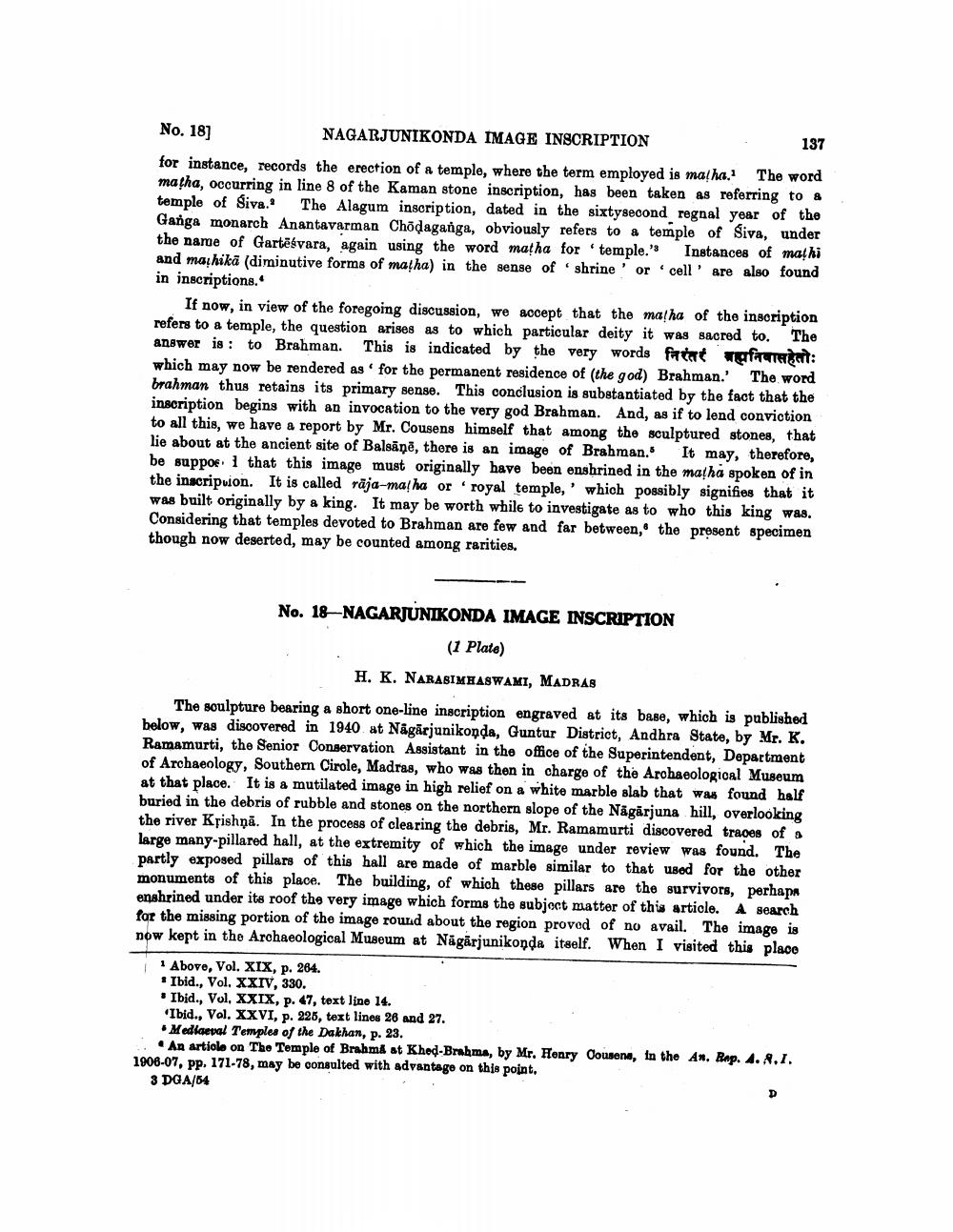________________
No. 18]
NAGARJUNIKONDA IMAGE INSCRIPTION
137
for instance, records the erection of a temple, where the term employed is matha. The word matha, occurring in line 8 of the Kaman stone inscription, has been taken as referring to a temple of Siva. The Alagum inscription, dated in the sixtysecond regnal year of the Ganga monarch Anantavarman Choḍaganga, obviously refers to a temple of Siva, under the name of Gartesvara, again using the word matha for temple." Instances of mathi and mathika (diminutive forms of matha) in the sense of shrine or cell are also found in inscriptions.
C
C
The
If now, in view of the foregoing discussion, we accept that the matha of the inscription refers to a temple, the question arises as to which particular deity it was sacred to. answer is to Brahman. This is indicated by the very words निरंतरं ब्रह्मनिवास हेतोः which may now be rendered as for the permanent residence of (the god) Brahman.' The word brahman thus retains its primary sense. This conclusion is substantiated by the fact that the inscription begins with an invocation to the very god Brahman. And, as if to lend conviction to all this, we have a report by Mr. Cousens himself that among the sculptured stones, that lie about at the ancient site of Balsaņē, there is an image of Brahman." be suppos 1 that this image must originally have been enshrined in the matha spoken of in It may, therefore, the inscription. It is called raja-matha or royal temple, which possibly signifies that it was built originally by a king. It may be worth while to investigate as to who this king was. Considering that temples devoted to Brahman are few and far between, the present specimen though now deserted, may be counted among rarities.
No. 18-NAGARJUNIKONDA IMAGE INSCRIPTION
(1 Plate)
H. K. NARASIMHASWAMI, MADRAS
The sculpture bearing a short one-line inscription engraved at its base, which is published below, was discovered in 1940 at Nagarjunikonda, Guntur District, Andhra State, by Mr. K. Ramamurti, the Senior Conservation Assistant in the office of the Superintendent, Department of Archaeology, Southern Cirole, Madras, who was then in charge of the Archaeological Museum at that place. It is a mutilated image in high relief on a white marble slab that was found half buried in the debris of rubble and stones on the northern slope of the Nagarjuna hill, overlooking the river Krishna. In the process of clearing the debris, Mr. Ramamurti discovered traces of a large many-pillared hall, at the extremity of which the image under review was found. The partly exposed pillars of this hall are made of marble similar to that used for the other monuments of this place. The building, of which these pillars are the survivors, perhaps enshrined under its roof the very image which forms the subject matter of this article. A search for the missing portion of the image round about the region proved of no avail. The image is now kept in the Archaeological Museum at Nagarjunikonda itself. When I visited this place
1 Above, Vol. XIX, p. 264. Ibid., Vol. XXIV, 330.
Ibid., Vol. XXIX, p. 47, text line 14.
'Ibid., Vol. XXVI, p. 225, text lines 26 and 27.
Mediaeval Temples of the Dakhan, p. 23.
An article on The Temple of Brahma at Khed-Brahma, by Mr. Henry Cousens, in the An. Rep. 4. R.I. 1906-07, pp. 171-78, may be consulted with advantage on this point.
3 DGA/54




